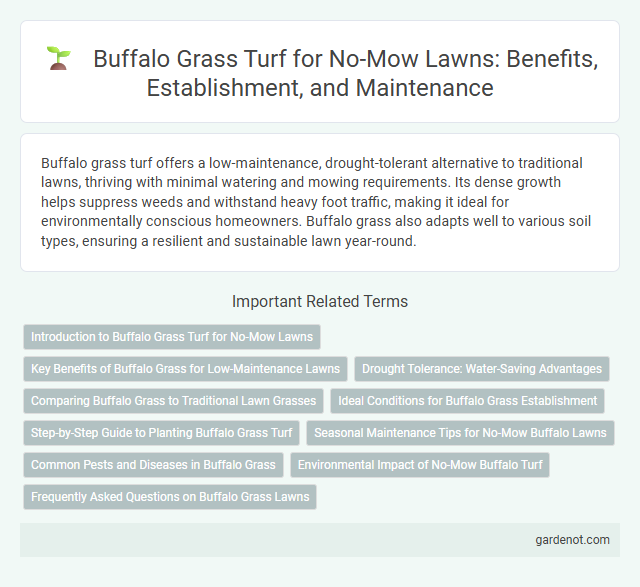Buffalo grass turf offers a low-maintenance, drought-tolerant alternative to traditional lawns, thriving with minimal watering and mowing requirements. Its dense growth helps suppress weeds and withstand heavy foot traffic, making it ideal for environmentally conscious homeowners. Buffalo grass also adapts well to various soil types, ensuring a resilient and sustainable lawn year-round.
Introduction to Buffalo Grass Turf for No-Mow Lawns
Buffalo grass turf, known for its drought tolerance and low maintenance requirements, is an ideal choice for no-mow lawns. This warm-season grass thrives in hot, dry climates, requiring minimal watering and infrequent mowing due to its slow growth. Its dense, fine-bladed texture creates a soft, resilient turf that reduces the need for regular lawn care while maintaining an attractive green appearance.
Key Benefits of Buffalo Grass for Low-Maintenance Lawns
Buffalo grass turf offers exceptional drought tolerance, requiring minimal watering compared to traditional grass varieties, which reduces water bills and environmental impact. Its slow growth rate means less frequent mowing, saving time and effort in lawn maintenance. Buffalo grass also provides excellent resistance to pests and diseases, ensuring a durable and healthy lawn with minimal chemical treatments.
Drought Tolerance: Water-Saving Advantages
Buffalo grass turf offers superior drought tolerance, requiring significantly less water compared to traditional lawn grasses. Its deep root system enables efficient moisture retention, reducing irrigation needs by up to 50%. This water-saving advantage makes Buffalo grass an ideal eco-friendly choice for sustainable landscaping in arid and drought-prone regions.
Comparing Buffalo Grass to Traditional Lawn Grasses
Buffalo grass turf offers superior drought resistance and requires significantly less water compared to traditional lawn grasses like Kentucky bluegrass or fescue, making it ideal for sustainable, no-mow lawns. Its deep root system enhances soil health and reduces erosion, while its slow growth habit minimizes mowing frequency, cutting maintenance time by up to 75%. Buffalo grass also thrives in warm climates with minimal fertilization, contrasting with conventional grasses that demand high inputs and frequent care for optimal appearance.
Ideal Conditions for Buffalo Grass Establishment
Buffalo grass thrives best in well-drained soils with a pH range between 6.0 and 7.5, ensuring optimal nutrient availability and root development. It prefers full sun exposure, requiring at least six to eight hours daily to maintain its dense, drought-resistant turf. Moderate watering during establishment, approximately 1 inch per week, supports deep rooting without causing waterlogging or encouraging fungal growth.
Step-by-Step Guide to Planting Buffalo Grass Turf
Buffalo grass turf thrives in well-drained soil with full sun exposure, making site preparation crucial for successful planting. Begin by removing existing vegetation and loosening the soil to a depth of 4-6 inches before laying the buffalo grass plugs or sod evenly across the area. Water thoroughly after planting and maintain consistent moisture for the first 3-4 weeks to promote strong root establishment and a lush, drought-resistant lawn.
Seasonal Maintenance Tips for No-Mow Buffalo Lawns
Buffalo grass turf requires minimal seasonal upkeep, making it ideal for no-mow lawns. In spring, apply a slow-release fertilizer to encourage healthy growth and aerate the soil to improve root development. During summer, maintain adequate soil moisture by watering deeply but infrequently, and overseed sparse areas in early fall to promote thick, resilient turf.
Common Pests and Diseases in Buffalo Grass
Buffalo grass turf is generally resilient but can be affected by pests such as buffalo beetles, chinch bugs, and armyworms, which feed on the blades and roots. Common diseases include leaf spot, caused by Bipolaris species, and rust fungus, which results in orange-brown pustules on grass blades. Regular monitoring and proper lawn care practices such as adequate watering and mowing height adjustments help in managing these pests and diseases effectively.
Environmental Impact of No-Mow Buffalo Turf
No-mow Buffalo grass turf significantly reduces water consumption by requiring up to 50% less irrigation compared to traditional lawns, promoting sustainable water management. Its deep root system enhances soil health and carbon sequestration, mitigating urban heat island effects and lowering greenhouse gas emissions. The reduced need for mowing cuts down fossil fuel use and air pollution, contributing to a cleaner environment.
Frequently Asked Questions on Buffalo Grass Lawns
Buffalo grass turf is a popular no-mow lawn choice due to its low maintenance and drought tolerance. Frequently asked questions about Buffalo grass often include its growth rate, ideal soil type, and water requirements, with experts recommending minimal mowing once established and well-drained, sandy soil for optimal growth. This warm-season grass thrives in full sun and requires significantly less water than traditional lawn grasses, making it an environmentally friendly turf option.
Buffalo grass turf Infographic

 gardenot.com
gardenot.com